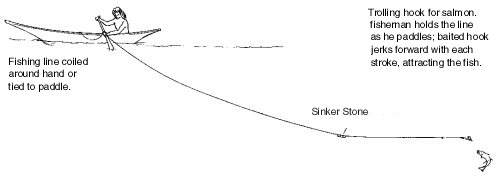

 |
 |
|
Trolling is another method used to catch salmon along the British Columbia coast. Trolling with a hand-held fishing line is sometimes called handlining. First Nations people were the first to use this method to catch salmon here on the coast. Coho and Springs were the only two types of salmon usually caught using this fishing technique because they are the species that most often rises to bait. First Nations fishermen trolled for salmon from dugout canoes using a fishing line and hook. The hook and line was especially effective in bays and inlets where salmon grouped together before going up river to spawn. 
Drawing of a fisherman handlining for salmon from a canoe. Images © Hilary Stewart. Indian Fishing: Early Methods on the Northwest Coast. p. 41.
Fishing lines could be made of treated bull kelp, nettle fibres or cedar bark (which was what the Lekwiltok peoples of the Campbell River area used). Lures and smaller fish, such as herring, were often attached to the hook and used to entice the salmon. Fishermen would hold onto the fishing line as they paddled. The movement of the paddle caused the bait to jerk back and forth. This motion made it appear as if the bait was lame, attracting the prey. A sinker stone was also used to keep the line and hook at the desired depth. When the fish was hooked it would be hauled into the canoe and hit on the head with a wooden club. The Lekwiltok peoples, trolling off Quadra, were noted as being able to catch up to 100 fish in a day. When going after the larger Tyee using a line and hook, the Lekwiltok peoples often used a slightly different technique. Attached to the end of the line would be a cedar float block. Once the fish was hooked, the fisherman would let the line out as the Tyee ran, and when the line ran out he would let go of it. He would then follow the floating block as the Tyee wore itself out. When the Tyee was spent, the fisherman would go to where the float was, haul in the line, and club the salmon. First Nations fishermen started trolling long before it became an industry, and they were among the first to take it up as a commercial trade. They began the trade using canoes and handlining methods, and later, with ever changing technology, adopted trolling boats, and poles and lines. By 1899, trolling became part of the commercial fishing industry in BC.
The tools of the trade for a European handliner consisted of an open rowboat or a skiff with sail, cotton lines, a hook, lead weights, a herring rake, gut leaders, and homemade brass spinners and spoons. Later came the fishing rod and reel which replaced the hand held line. The lack of a small power source for troll boats limited the early development and spread of trolling. However, when the small marina gas engine was developed, in the early 1900s, the commercial trolling industry and fleet took off. Handlining was very popular during the Depression but dropped out of use in the 1940s. Many innovations in the trolling industry occurred from 1910 through until the 1930s. For instance, the hand gurdie that was used to reel in and control the lines made life easier for the fisherman, but the power-gurdies that came into use in 1918 sped up the whole process. Before World War II wire lines replaced cotton ones and later, stainless steel lines became the norm. After World War II, two different types of trolling boats began to emerge: the small kelpers and the large trolling boats. The kelpers were one to two man boats that were small enough to move around by automobile and trailer. They did not need the heavy gear of the larger trollers. These boats were easier to maneuver, making them ideal for catching Chinook in areas where the larger boats could not go. The kelper was mainly used in rocky, kelp-thick areas close to shore, or where strong currents exist. This boat's portability, combined with the import of the inboard-outboard motor from Europe in1958, led to the rise of sport boating.
In contrast, the larger trolling boats had more gear and lines on them. By the 1960s refrigeration units on board became so advanced that boats could stay out to sea for up to a month at a time. With high-speed diesel engines, hydraulic gurdies, and multi-strand stainless steel fishing lines, these boats could catch more fish per hour than ever before. These innovations allowed trollers to compete in the offshore and inshore pink and sockeye fisheries as well as in more traditional fisheries.
Currently, large commercial trolling boats have electronic fish finding gear, stabilizers, and up to eight separate spools of stainless steel trolling wire, each with one or two sets of lures. The lines or wires are led through four long poles, two mounted in the middle of the boat and two in front of the wheelhouse. This large number of lines increases the fishermen's chances of catching fish., making trolling a lucrative business even today. |